P&FCC: Comparing Traditional Model with Application to Case Studies
VerifiedAdded on 2023/04/25
|12
|3327
|128
Case Study
AI Summary
This case study examines the shift from the traditional nursing model to patient and family-centered care (P&FCC), highlighting the positive impacts of P&FCC on children's and families' well-being, including empowerment and reduced psychological distress. It contrasts the traditional model, where nurses held authority, with P&FCC, which prioritizes shared decision-making and open communication. Two key concepts of P&FCC—open communication and family involvement in decision-making—are discussed, emphasizing information sharing. The study applies these principles to two case studies: a 3-year-old experiencing separation anxiety and a 16-year-old struggling with body image and control. Strategies to mitigate the negative impacts of hospitalization, such as providing toys and incorporating parents in care, are explored. The case study concludes that P&FCC significantly improves the mental and physical health of children, especially when parents face psychological distress.

Running head: PATIENT CENTRIC CARE
Name of the student;
Name of the university:
Author note:
Name of the student;
Name of the university:
Author note:
Paraphrase This Document
Need a fresh take? Get an instant paraphrase of this document with our AI Paraphraser
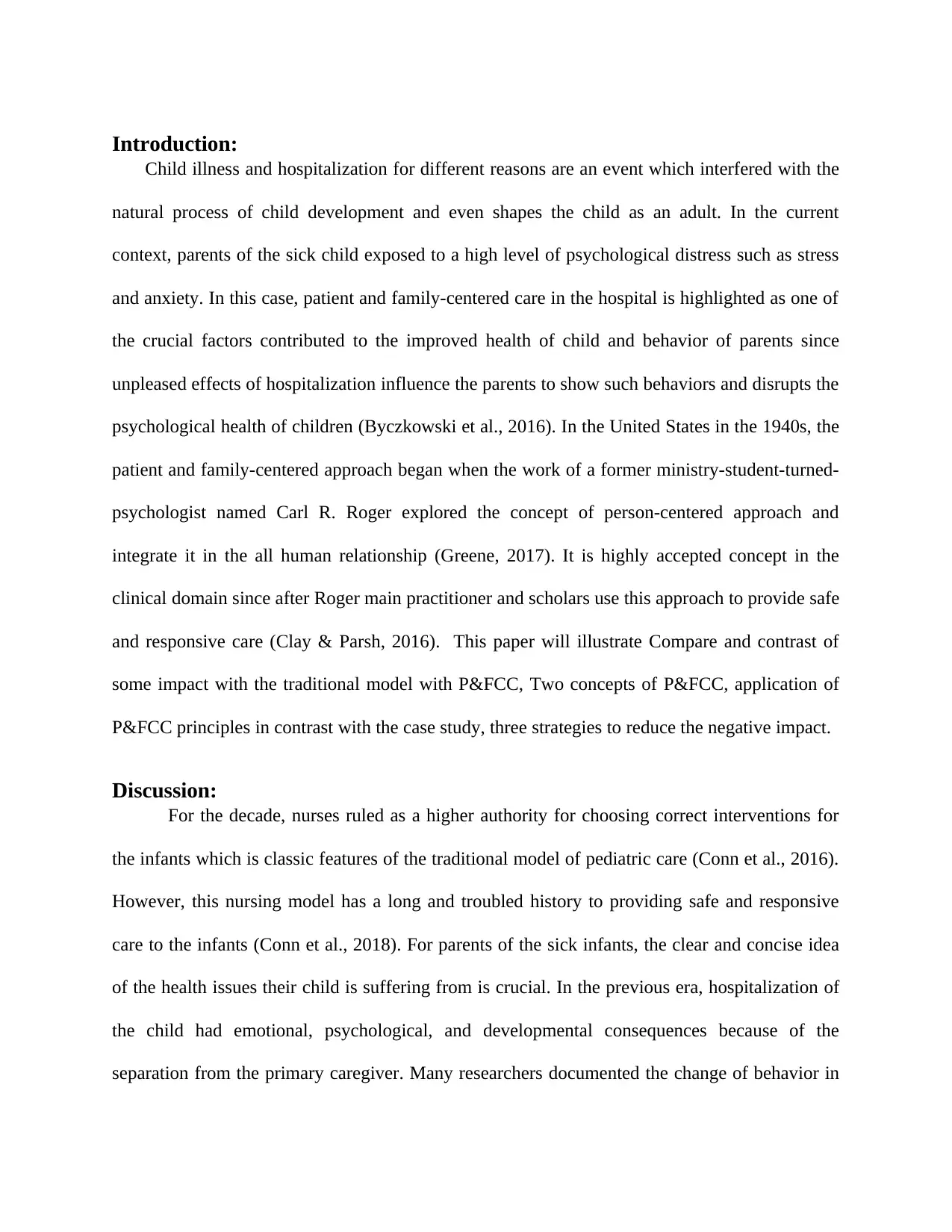
Introduction:
Child illness and hospitalization for different reasons are an event which interfered with the
natural process of child development and even shapes the child as an adult. In the current
context, parents of the sick child exposed to a high level of psychological distress such as stress
and anxiety. In this case, patient and family-centered care in the hospital is highlighted as one of
the crucial factors contributed to the improved health of child and behavior of parents since
unpleased effects of hospitalization influence the parents to show such behaviors and disrupts the
psychological health of children (Byczkowski et al., 2016). In the United States in the 1940s, the
patient and family-centered approach began when the work of a former ministry-student-turned-
psychologist named Carl R. Roger explored the concept of person-centered approach and
integrate it in the all human relationship (Greene, 2017). It is highly accepted concept in the
clinical domain since after Roger main practitioner and scholars use this approach to provide safe
and responsive care (Clay & Parsh, 2016). This paper will illustrate Compare and contrast of
some impact with the traditional model with P&FCC, Two concepts of P&FCC, application of
P&FCC principles in contrast with the case study, three strategies to reduce the negative impact.
Discussion:
For the decade, nurses ruled as a higher authority for choosing correct interventions for
the infants which is classic features of the traditional model of pediatric care (Conn et al., 2016).
However, this nursing model has a long and troubled history to providing safe and responsive
care to the infants (Conn et al., 2018). For parents of the sick infants, the clear and concise idea
of the health issues their child is suffering from is crucial. In the previous era, hospitalization of
the child had emotional, psychological, and developmental consequences because of the
separation from the primary caregiver. Many researchers documented the change of behavior in
Child illness and hospitalization for different reasons are an event which interfered with the
natural process of child development and even shapes the child as an adult. In the current
context, parents of the sick child exposed to a high level of psychological distress such as stress
and anxiety. In this case, patient and family-centered care in the hospital is highlighted as one of
the crucial factors contributed to the improved health of child and behavior of parents since
unpleased effects of hospitalization influence the parents to show such behaviors and disrupts the
psychological health of children (Byczkowski et al., 2016). In the United States in the 1940s, the
patient and family-centered approach began when the work of a former ministry-student-turned-
psychologist named Carl R. Roger explored the concept of person-centered approach and
integrate it in the all human relationship (Greene, 2017). It is highly accepted concept in the
clinical domain since after Roger main practitioner and scholars use this approach to provide safe
and responsive care (Clay & Parsh, 2016). This paper will illustrate Compare and contrast of
some impact with the traditional model with P&FCC, Two concepts of P&FCC, application of
P&FCC principles in contrast with the case study, three strategies to reduce the negative impact.
Discussion:
For the decade, nurses ruled as a higher authority for choosing correct interventions for
the infants which is classic features of the traditional model of pediatric care (Conn et al., 2016).
However, this nursing model has a long and troubled history to providing safe and responsive
care to the infants (Conn et al., 2018). For parents of the sick infants, the clear and concise idea
of the health issues their child is suffering from is crucial. In the previous era, hospitalization of
the child had emotional, psychological, and developmental consequences because of the
separation from the primary caregiver. Many researchers documented the change of behavior in
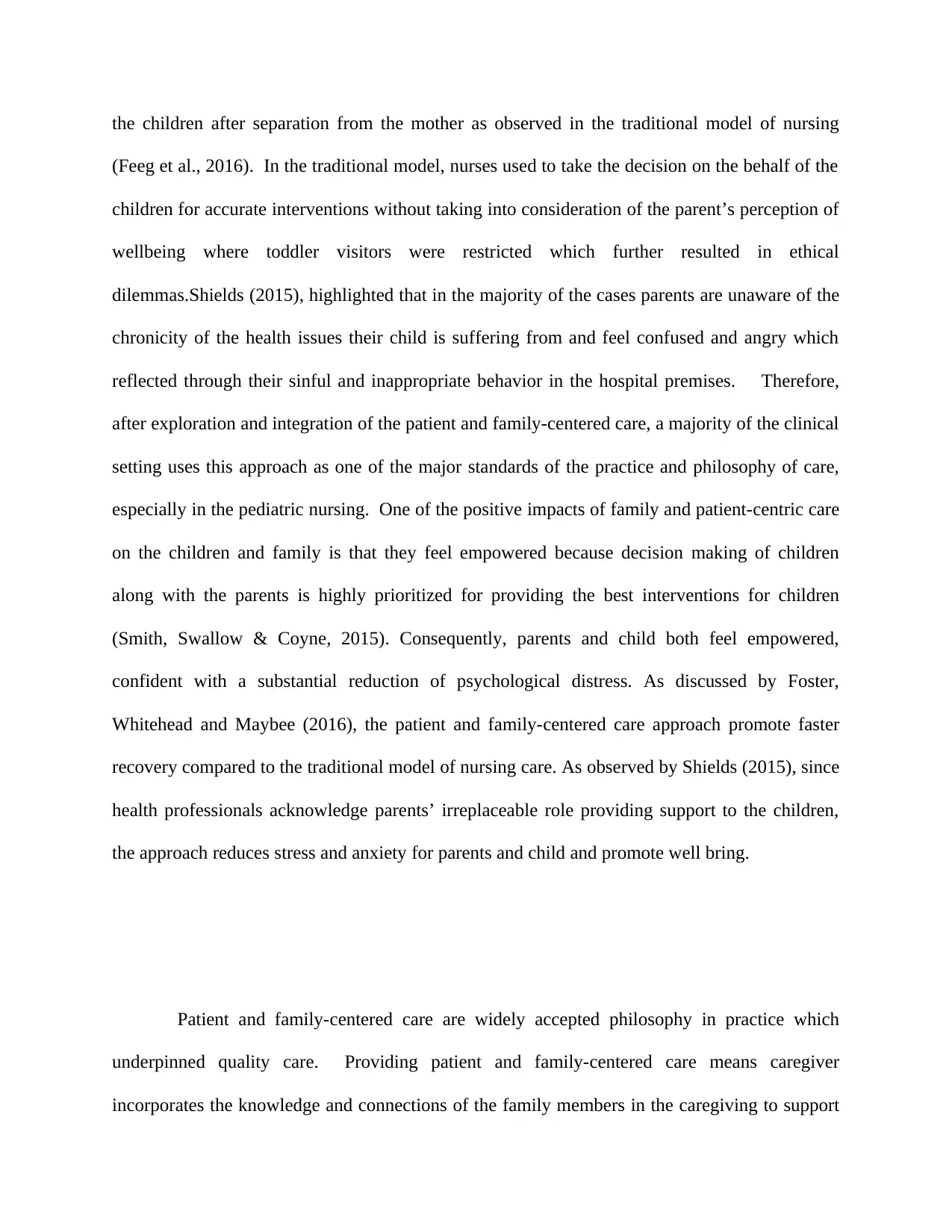
the children after separation from the mother as observed in the traditional model of nursing
(Feeg et al., 2016). In the traditional model, nurses used to take the decision on the behalf of the
children for accurate interventions without taking into consideration of the parent’s perception of
wellbeing where toddler visitors were restricted which further resulted in ethical
dilemmas.Shields (2015), highlighted that in the majority of the cases parents are unaware of the
chronicity of the health issues their child is suffering from and feel confused and angry which
reflected through their sinful and inappropriate behavior in the hospital premises. Therefore,
after exploration and integration of the patient and family-centered care, a majority of the clinical
setting uses this approach as one of the major standards of the practice and philosophy of care,
especially in the pediatric nursing. One of the positive impacts of family and patient-centric care
on the children and family is that they feel empowered because decision making of children
along with the parents is highly prioritized for providing the best interventions for children
(Smith, Swallow & Coyne, 2015). Consequently, parents and child both feel empowered,
confident with a substantial reduction of psychological distress. As discussed by Foster,
Whitehead and Maybee (2016), the patient and family-centered care approach promote faster
recovery compared to the traditional model of nursing care. As observed by Shields (2015), since
health professionals acknowledge parents’ irreplaceable role providing support to the children,
the approach reduces stress and anxiety for parents and child and promote well bring.
Patient and family-centered care are widely accepted philosophy in practice which
underpinned quality care. Providing patient and family-centered care means caregiver
incorporates the knowledge and connections of the family members in the caregiving to support
(Feeg et al., 2016). In the traditional model, nurses used to take the decision on the behalf of the
children for accurate interventions without taking into consideration of the parent’s perception of
wellbeing where toddler visitors were restricted which further resulted in ethical
dilemmas.Shields (2015), highlighted that in the majority of the cases parents are unaware of the
chronicity of the health issues their child is suffering from and feel confused and angry which
reflected through their sinful and inappropriate behavior in the hospital premises. Therefore,
after exploration and integration of the patient and family-centered care, a majority of the clinical
setting uses this approach as one of the major standards of the practice and philosophy of care,
especially in the pediatric nursing. One of the positive impacts of family and patient-centric care
on the children and family is that they feel empowered because decision making of children
along with the parents is highly prioritized for providing the best interventions for children
(Smith, Swallow & Coyne, 2015). Consequently, parents and child both feel empowered,
confident with a substantial reduction of psychological distress. As discussed by Foster,
Whitehead and Maybee (2016), the patient and family-centered care approach promote faster
recovery compared to the traditional model of nursing care. As observed by Shields (2015), since
health professionals acknowledge parents’ irreplaceable role providing support to the children,
the approach reduces stress and anxiety for parents and child and promote well bring.
Patient and family-centered care are widely accepted philosophy in practice which
underpinned quality care. Providing patient and family-centered care means caregiver
incorporates the knowledge and connections of the family members in the caregiving to support
⊘ This is a preview!⊘
Do you want full access?
Subscribe today to unlock all pages.

Trusted by 1+ million students worldwide
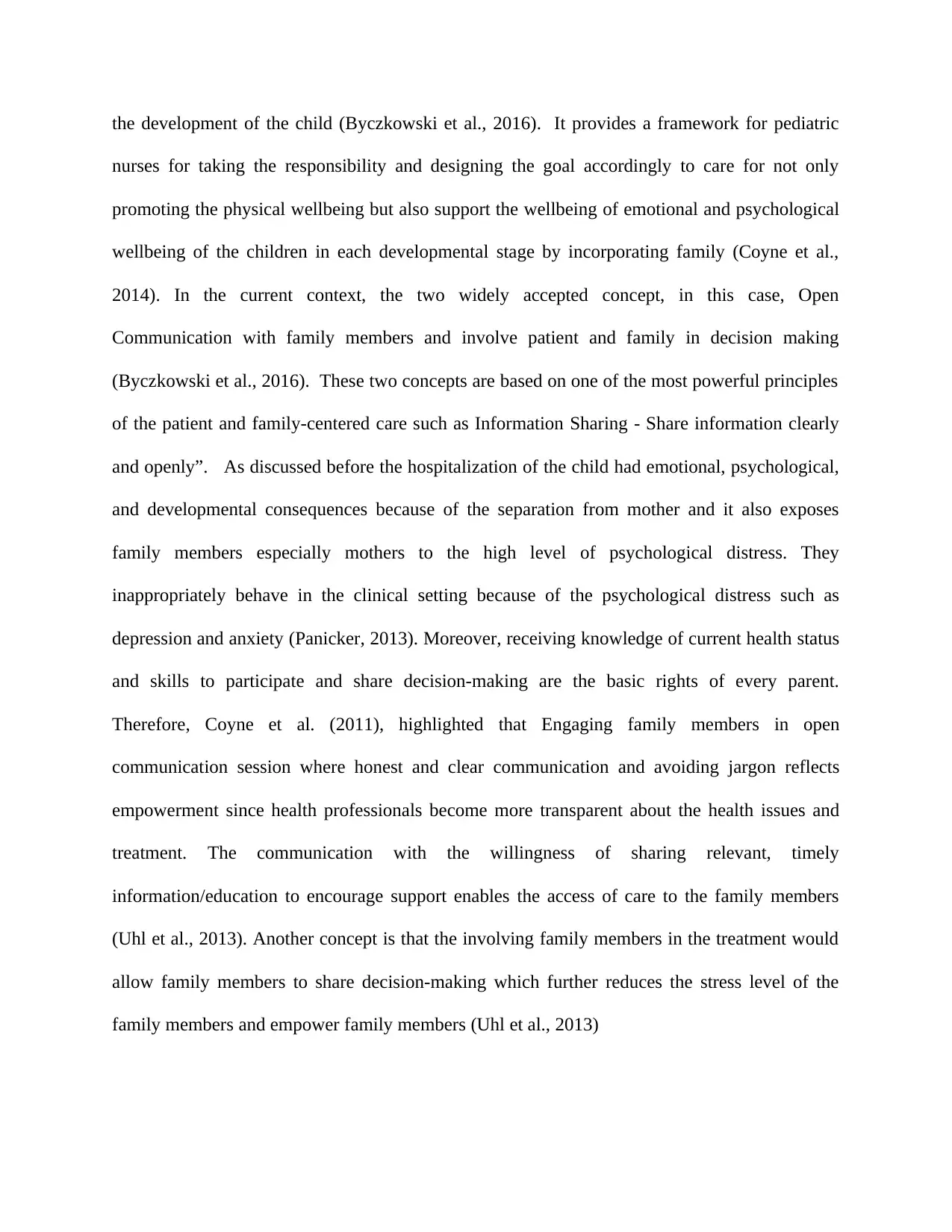
the development of the child (Byczkowski et al., 2016). It provides a framework for pediatric
nurses for taking the responsibility and designing the goal accordingly to care for not only
promoting the physical wellbeing but also support the wellbeing of emotional and psychological
wellbeing of the children in each developmental stage by incorporating family (Coyne et al.,
2014). In the current context, the two widely accepted concept, in this case, Open
Communication with family members and involve patient and family in decision making
(Byczkowski et al., 2016). These two concepts are based on one of the most powerful principles
of the patient and family-centered care such as Information Sharing - Share information clearly
and openly”. As discussed before the hospitalization of the child had emotional, psychological,
and developmental consequences because of the separation from mother and it also exposes
family members especially mothers to the high level of psychological distress. They
inappropriately behave in the clinical setting because of the psychological distress such as
depression and anxiety (Panicker, 2013). Moreover, receiving knowledge of current health status
and skills to participate and share decision-making are the basic rights of every parent.
Therefore, Coyne et al. (2011), highlighted that Engaging family members in open
communication session where honest and clear communication and avoiding jargon reflects
empowerment since health professionals become more transparent about the health issues and
treatment. The communication with the willingness of sharing relevant, timely
information/education to encourage support enables the access of care to the family members
(Uhl et al., 2013). Another concept is that the involving family members in the treatment would
allow family members to share decision-making which further reduces the stress level of the
family members and empower family members (Uhl et al., 2013)
nurses for taking the responsibility and designing the goal accordingly to care for not only
promoting the physical wellbeing but also support the wellbeing of emotional and psychological
wellbeing of the children in each developmental stage by incorporating family (Coyne et al.,
2014). In the current context, the two widely accepted concept, in this case, Open
Communication with family members and involve patient and family in decision making
(Byczkowski et al., 2016). These two concepts are based on one of the most powerful principles
of the patient and family-centered care such as Information Sharing - Share information clearly
and openly”. As discussed before the hospitalization of the child had emotional, psychological,
and developmental consequences because of the separation from mother and it also exposes
family members especially mothers to the high level of psychological distress. They
inappropriately behave in the clinical setting because of the psychological distress such as
depression and anxiety (Panicker, 2013). Moreover, receiving knowledge of current health status
and skills to participate and share decision-making are the basic rights of every parent.
Therefore, Coyne et al. (2011), highlighted that Engaging family members in open
communication session where honest and clear communication and avoiding jargon reflects
empowerment since health professionals become more transparent about the health issues and
treatment. The communication with the willingness of sharing relevant, timely
information/education to encourage support enables the access of care to the family members
(Uhl et al., 2013). Another concept is that the involving family members in the treatment would
allow family members to share decision-making which further reduces the stress level of the
family members and empower family members (Uhl et al., 2013)
Paraphrase This Document
Need a fresh take? Get an instant paraphrase of this document with our AI Paraphraser
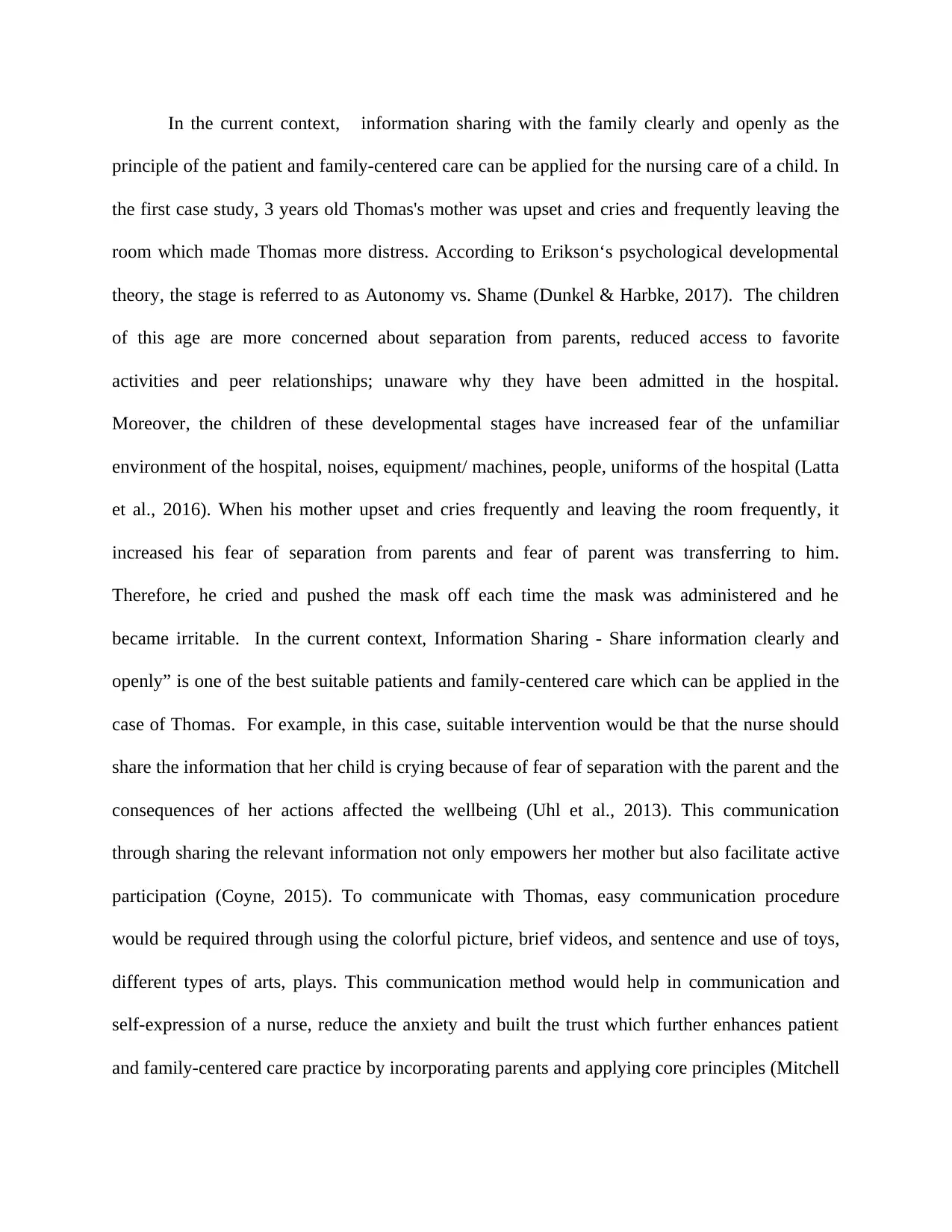
In the current context, information sharing with the family clearly and openly as the
principle of the patient and family-centered care can be applied for the nursing care of a child. In
the first case study, 3 years old Thomas's mother was upset and cries and frequently leaving the
room which made Thomas more distress. According to Erikson‘s psychological developmental
theory, the stage is referred to as Autonomy vs. Shame (Dunkel & Harbke, 2017). The children
of this age are more concerned about separation from parents, reduced access to favorite
activities and peer relationships; unaware why they have been admitted in the hospital.
Moreover, the children of these developmental stages have increased fear of the unfamiliar
environment of the hospital, noises, equipment/ machines, people, uniforms of the hospital (Latta
et al., 2016). When his mother upset and cries frequently and leaving the room frequently, it
increased his fear of separation from parents and fear of parent was transferring to him.
Therefore, he cried and pushed the mask off each time the mask was administered and he
became irritable. In the current context, Information Sharing - Share information clearly and
openly” is one of the best suitable patients and family-centered care which can be applied in the
case of Thomas. For example, in this case, suitable intervention would be that the nurse should
share the information that her child is crying because of fear of separation with the parent and the
consequences of her actions affected the wellbeing (Uhl et al., 2013). This communication
through sharing the relevant information not only empowers her mother but also facilitate active
participation (Coyne, 2015). To communicate with Thomas, easy communication procedure
would be required through using the colorful picture, brief videos, and sentence and use of toys,
different types of arts, plays. This communication method would help in communication and
self-expression of a nurse, reduce the anxiety and built the trust which further enhances patient
and family-centered care practice by incorporating parents and applying core principles (Mitchell
principle of the patient and family-centered care can be applied for the nursing care of a child. In
the first case study, 3 years old Thomas's mother was upset and cries and frequently leaving the
room which made Thomas more distress. According to Erikson‘s psychological developmental
theory, the stage is referred to as Autonomy vs. Shame (Dunkel & Harbke, 2017). The children
of this age are more concerned about separation from parents, reduced access to favorite
activities and peer relationships; unaware why they have been admitted in the hospital.
Moreover, the children of these developmental stages have increased fear of the unfamiliar
environment of the hospital, noises, equipment/ machines, people, uniforms of the hospital (Latta
et al., 2016). When his mother upset and cries frequently and leaving the room frequently, it
increased his fear of separation from parents and fear of parent was transferring to him.
Therefore, he cried and pushed the mask off each time the mask was administered and he
became irritable. In the current context, Information Sharing - Share information clearly and
openly” is one of the best suitable patients and family-centered care which can be applied in the
case of Thomas. For example, in this case, suitable intervention would be that the nurse should
share the information that her child is crying because of fear of separation with the parent and the
consequences of her actions affected the wellbeing (Uhl et al., 2013). This communication
through sharing the relevant information not only empowers her mother but also facilitate active
participation (Coyne, 2015). To communicate with Thomas, easy communication procedure
would be required through using the colorful picture, brief videos, and sentence and use of toys,
different types of arts, plays. This communication method would help in communication and
self-expression of a nurse, reduce the anxiety and built the trust which further enhances patient
and family-centered care practice by incorporating parents and applying core principles (Mitchell
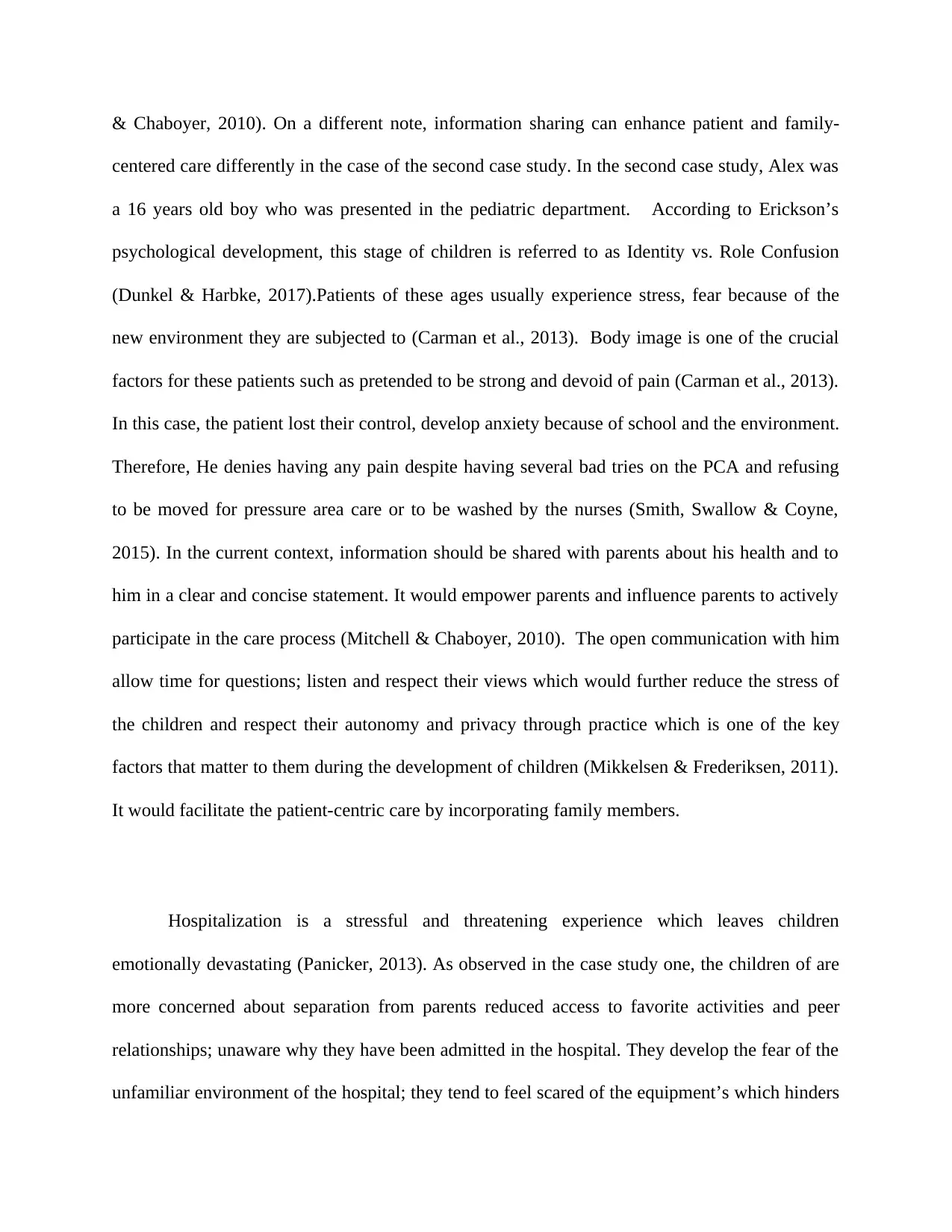
& Chaboyer, 2010). On a different note, information sharing can enhance patient and family-
centered care differently in the case of the second case study. In the second case study, Alex was
a 16 years old boy who was presented in the pediatric department. According to Erickson’s
psychological development, this stage of children is referred to as Identity vs. Role Confusion
(Dunkel & Harbke, 2017).Patients of these ages usually experience stress, fear because of the
new environment they are subjected to (Carman et al., 2013). Body image is one of the crucial
factors for these patients such as pretended to be strong and devoid of pain (Carman et al., 2013).
In this case, the patient lost their control, develop anxiety because of school and the environment.
Therefore, He denies having any pain despite having several bad tries on the PCA and refusing
to be moved for pressure area care or to be washed by the nurses (Smith, Swallow & Coyne,
2015). In the current context, information should be shared with parents about his health and to
him in a clear and concise statement. It would empower parents and influence parents to actively
participate in the care process (Mitchell & Chaboyer, 2010). The open communication with him
allow time for questions; listen and respect their views which would further reduce the stress of
the children and respect their autonomy and privacy through practice which is one of the key
factors that matter to them during the development of children (Mikkelsen & Frederiksen, 2011).
It would facilitate the patient-centric care by incorporating family members.
Hospitalization is a stressful and threatening experience which leaves children
emotionally devastating (Panicker, 2013). As observed in the case study one, the children of are
more concerned about separation from parents reduced access to favorite activities and peer
relationships; unaware why they have been admitted in the hospital. They develop the fear of the
unfamiliar environment of the hospital; they tend to feel scared of the equipment’s which hinders
centered care differently in the case of the second case study. In the second case study, Alex was
a 16 years old boy who was presented in the pediatric department. According to Erickson’s
psychological development, this stage of children is referred to as Identity vs. Role Confusion
(Dunkel & Harbke, 2017).Patients of these ages usually experience stress, fear because of the
new environment they are subjected to (Carman et al., 2013). Body image is one of the crucial
factors for these patients such as pretended to be strong and devoid of pain (Carman et al., 2013).
In this case, the patient lost their control, develop anxiety because of school and the environment.
Therefore, He denies having any pain despite having several bad tries on the PCA and refusing
to be moved for pressure area care or to be washed by the nurses (Smith, Swallow & Coyne,
2015). In the current context, information should be shared with parents about his health and to
him in a clear and concise statement. It would empower parents and influence parents to actively
participate in the care process (Mitchell & Chaboyer, 2010). The open communication with him
allow time for questions; listen and respect their views which would further reduce the stress of
the children and respect their autonomy and privacy through practice which is one of the key
factors that matter to them during the development of children (Mikkelsen & Frederiksen, 2011).
It would facilitate the patient-centric care by incorporating family members.
Hospitalization is a stressful and threatening experience which leaves children
emotionally devastating (Panicker, 2013). As observed in the case study one, the children of are
more concerned about separation from parents reduced access to favorite activities and peer
relationships; unaware why they have been admitted in the hospital. They develop the fear of the
unfamiliar environment of the hospital; they tend to feel scared of the equipment’s which hinders
⊘ This is a preview!⊘
Do you want full access?
Subscribe today to unlock all pages.

Trusted by 1+ million students worldwide
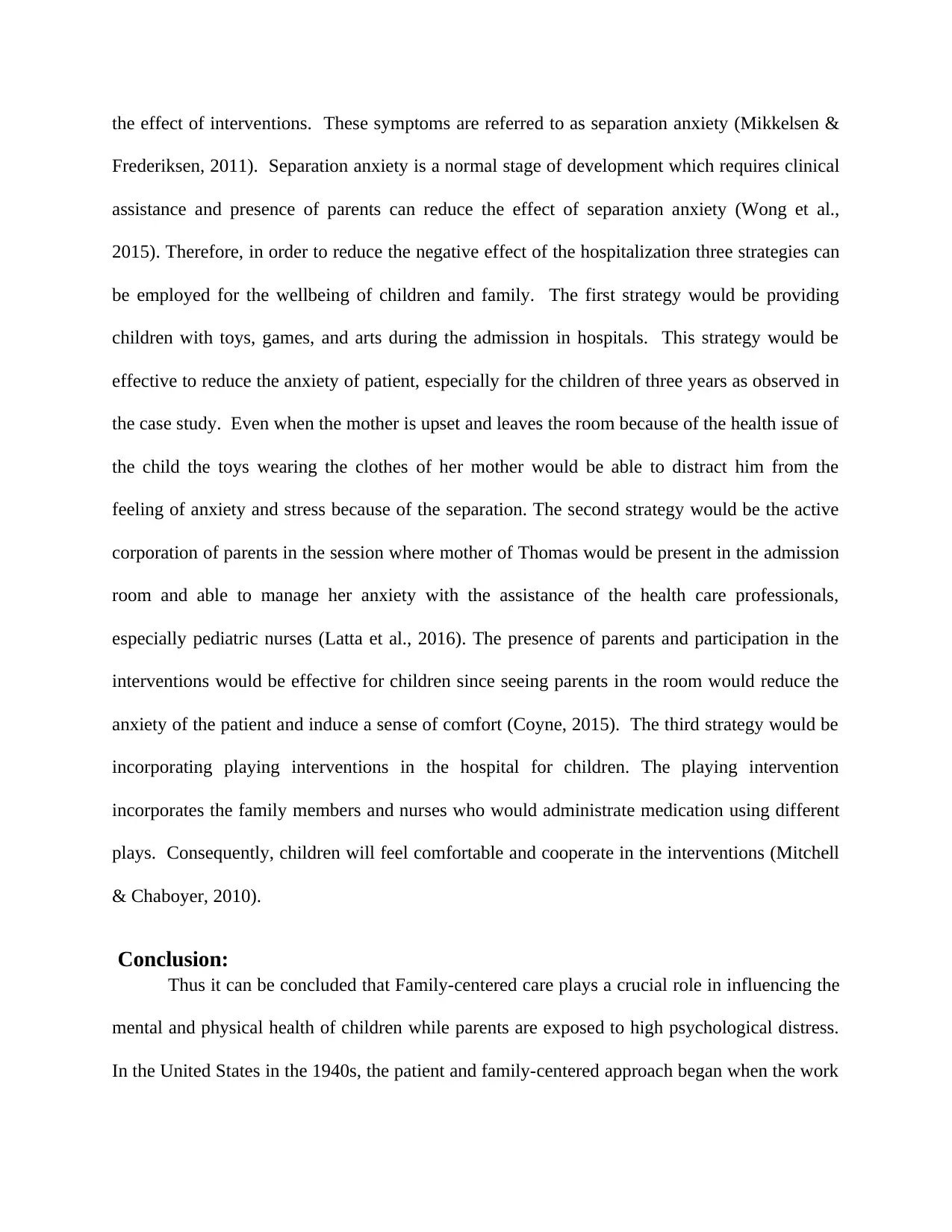
the effect of interventions. These symptoms are referred to as separation anxiety (Mikkelsen &
Frederiksen, 2011). Separation anxiety is a normal stage of development which requires clinical
assistance and presence of parents can reduce the effect of separation anxiety (Wong et al.,
2015). Therefore, in order to reduce the negative effect of the hospitalization three strategies can
be employed for the wellbeing of children and family. The first strategy would be providing
children with toys, games, and arts during the admission in hospitals. This strategy would be
effective to reduce the anxiety of patient, especially for the children of three years as observed in
the case study. Even when the mother is upset and leaves the room because of the health issue of
the child the toys wearing the clothes of her mother would be able to distract him from the
feeling of anxiety and stress because of the separation. The second strategy would be the active
corporation of parents in the session where mother of Thomas would be present in the admission
room and able to manage her anxiety with the assistance of the health care professionals,
especially pediatric nurses (Latta et al., 2016). The presence of parents and participation in the
interventions would be effective for children since seeing parents in the room would reduce the
anxiety of the patient and induce a sense of comfort (Coyne, 2015). The third strategy would be
incorporating playing interventions in the hospital for children. The playing intervention
incorporates the family members and nurses who would administrate medication using different
plays. Consequently, children will feel comfortable and cooperate in the interventions (Mitchell
& Chaboyer, 2010).
Conclusion:
Thus it can be concluded that Family-centered care plays a crucial role in influencing the
mental and physical health of children while parents are exposed to high psychological distress.
In the United States in the 1940s, the patient and family-centered approach began when the work
Frederiksen, 2011). Separation anxiety is a normal stage of development which requires clinical
assistance and presence of parents can reduce the effect of separation anxiety (Wong et al.,
2015). Therefore, in order to reduce the negative effect of the hospitalization three strategies can
be employed for the wellbeing of children and family. The first strategy would be providing
children with toys, games, and arts during the admission in hospitals. This strategy would be
effective to reduce the anxiety of patient, especially for the children of three years as observed in
the case study. Even when the mother is upset and leaves the room because of the health issue of
the child the toys wearing the clothes of her mother would be able to distract him from the
feeling of anxiety and stress because of the separation. The second strategy would be the active
corporation of parents in the session where mother of Thomas would be present in the admission
room and able to manage her anxiety with the assistance of the health care professionals,
especially pediatric nurses (Latta et al., 2016). The presence of parents and participation in the
interventions would be effective for children since seeing parents in the room would reduce the
anxiety of the patient and induce a sense of comfort (Coyne, 2015). The third strategy would be
incorporating playing interventions in the hospital for children. The playing intervention
incorporates the family members and nurses who would administrate medication using different
plays. Consequently, children will feel comfortable and cooperate in the interventions (Mitchell
& Chaboyer, 2010).
Conclusion:
Thus it can be concluded that Family-centered care plays a crucial role in influencing the
mental and physical health of children while parents are exposed to high psychological distress.
In the United States in the 1940s, the patient and family-centered approach began when the work
Paraphrase This Document
Need a fresh take? Get an instant paraphrase of this document with our AI Paraphraser
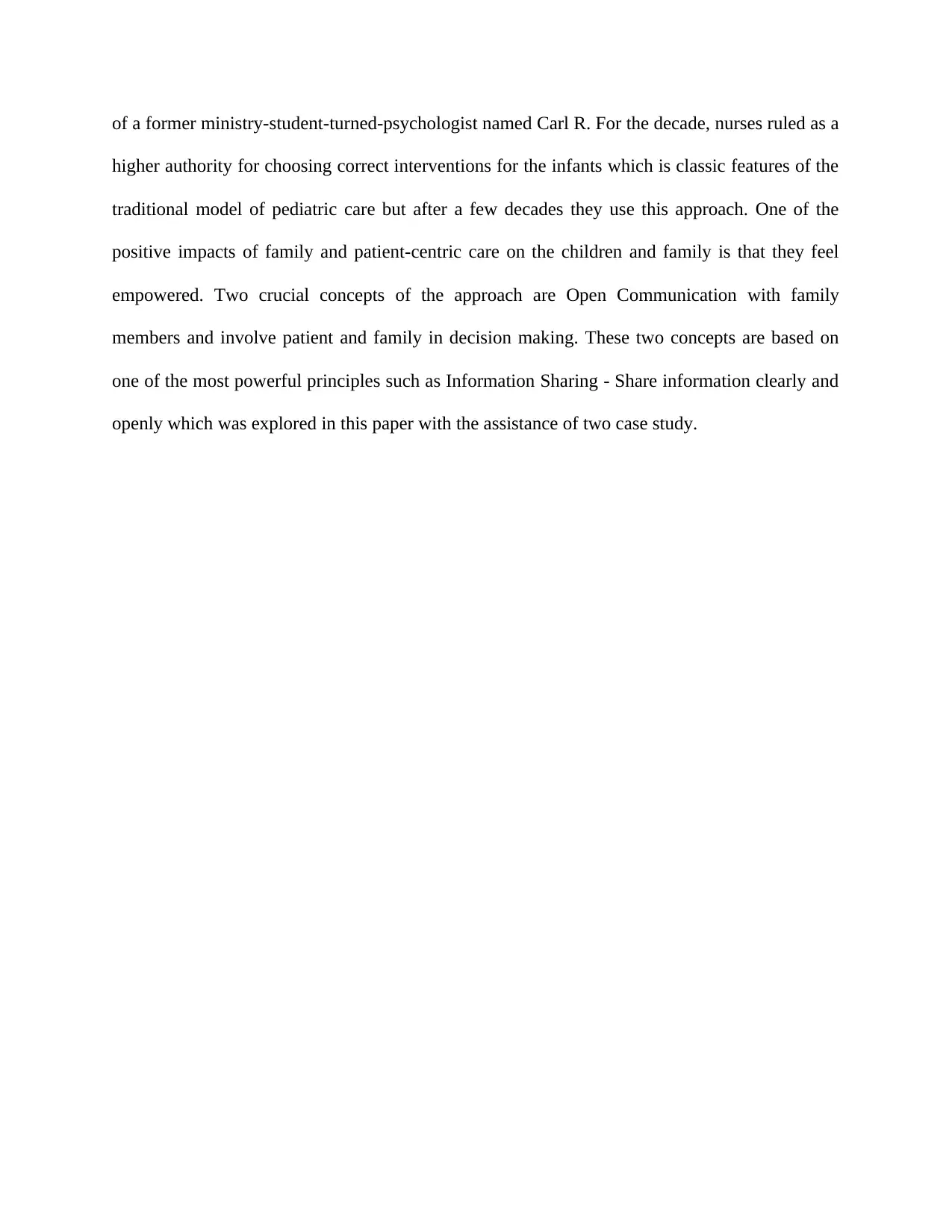
of a former ministry-student-turned-psychologist named Carl R. For the decade, nurses ruled as a
higher authority for choosing correct interventions for the infants which is classic features of the
traditional model of pediatric care but after a few decades they use this approach. One of the
positive impacts of family and patient-centric care on the children and family is that they feel
empowered. Two crucial concepts of the approach are Open Communication with family
members and involve patient and family in decision making. These two concepts are based on
one of the most powerful principles such as Information Sharing - Share information clearly and
openly which was explored in this paper with the assistance of two case study.
higher authority for choosing correct interventions for the infants which is classic features of the
traditional model of pediatric care but after a few decades they use this approach. One of the
positive impacts of family and patient-centric care on the children and family is that they feel
empowered. Two crucial concepts of the approach are Open Communication with family
members and involve patient and family in decision making. These two concepts are based on
one of the most powerful principles such as Information Sharing - Share information clearly and
openly which was explored in this paper with the assistance of two case study.
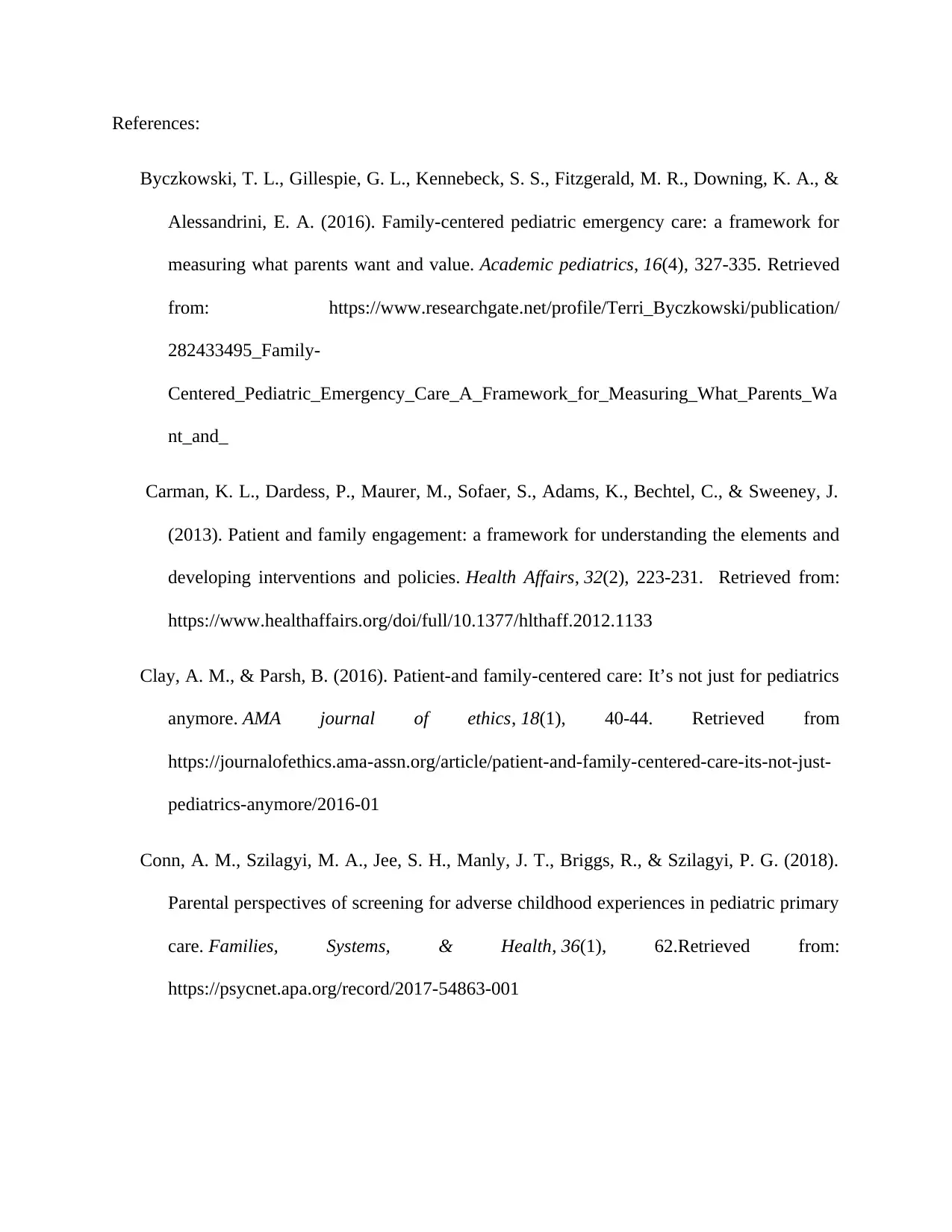
References:
Byczkowski, T. L., Gillespie, G. L., Kennebeck, S. S., Fitzgerald, M. R., Downing, K. A., &
Alessandrini, E. A. (2016). Family-centered pediatric emergency care: a framework for
measuring what parents want and value. Academic pediatrics, 16(4), 327-335. Retrieved
from: https://www.researchgate.net/profile/Terri_Byczkowski/publication/
282433495_Family-
Centered_Pediatric_Emergency_Care_A_Framework_for_Measuring_What_Parents_Wa
nt_and_
Carman, K. L., Dardess, P., Maurer, M., Sofaer, S., Adams, K., Bechtel, C., & Sweeney, J.
(2013). Patient and family engagement: a framework for understanding the elements and
developing interventions and policies. Health Affairs, 32(2), 223-231. Retrieved from:
https://www.healthaffairs.org/doi/full/10.1377/hlthaff.2012.1133
Clay, A. M., & Parsh, B. (2016). Patient-and family-centered care: It’s not just for pediatrics
anymore. AMA journal of ethics, 18(1), 40-44. Retrieved from
https://journalofethics.ama-assn.org/article/patient-and-family-centered-care-its-not-just-
pediatrics-anymore/2016-01
Conn, A. M., Szilagyi, M. A., Jee, S. H., Manly, J. T., Briggs, R., & Szilagyi, P. G. (2018).
Parental perspectives of screening for adverse childhood experiences in pediatric primary
care. Families, Systems, & Health, 36(1), 62.Retrieved from:
https://psycnet.apa.org/record/2017-54863-001
Byczkowski, T. L., Gillespie, G. L., Kennebeck, S. S., Fitzgerald, M. R., Downing, K. A., &
Alessandrini, E. A. (2016). Family-centered pediatric emergency care: a framework for
measuring what parents want and value. Academic pediatrics, 16(4), 327-335. Retrieved
from: https://www.researchgate.net/profile/Terri_Byczkowski/publication/
282433495_Family-
Centered_Pediatric_Emergency_Care_A_Framework_for_Measuring_What_Parents_Wa
nt_and_
Carman, K. L., Dardess, P., Maurer, M., Sofaer, S., Adams, K., Bechtel, C., & Sweeney, J.
(2013). Patient and family engagement: a framework for understanding the elements and
developing interventions and policies. Health Affairs, 32(2), 223-231. Retrieved from:
https://www.healthaffairs.org/doi/full/10.1377/hlthaff.2012.1133
Clay, A. M., & Parsh, B. (2016). Patient-and family-centered care: It’s not just for pediatrics
anymore. AMA journal of ethics, 18(1), 40-44. Retrieved from
https://journalofethics.ama-assn.org/article/patient-and-family-centered-care-its-not-just-
pediatrics-anymore/2016-01
Conn, A. M., Szilagyi, M. A., Jee, S. H., Manly, J. T., Briggs, R., & Szilagyi, P. G. (2018).
Parental perspectives of screening for adverse childhood experiences in pediatric primary
care. Families, Systems, & Health, 36(1), 62.Retrieved from:
https://psycnet.apa.org/record/2017-54863-001
⊘ This is a preview!⊘
Do you want full access?
Subscribe today to unlock all pages.

Trusted by 1+ million students worldwide
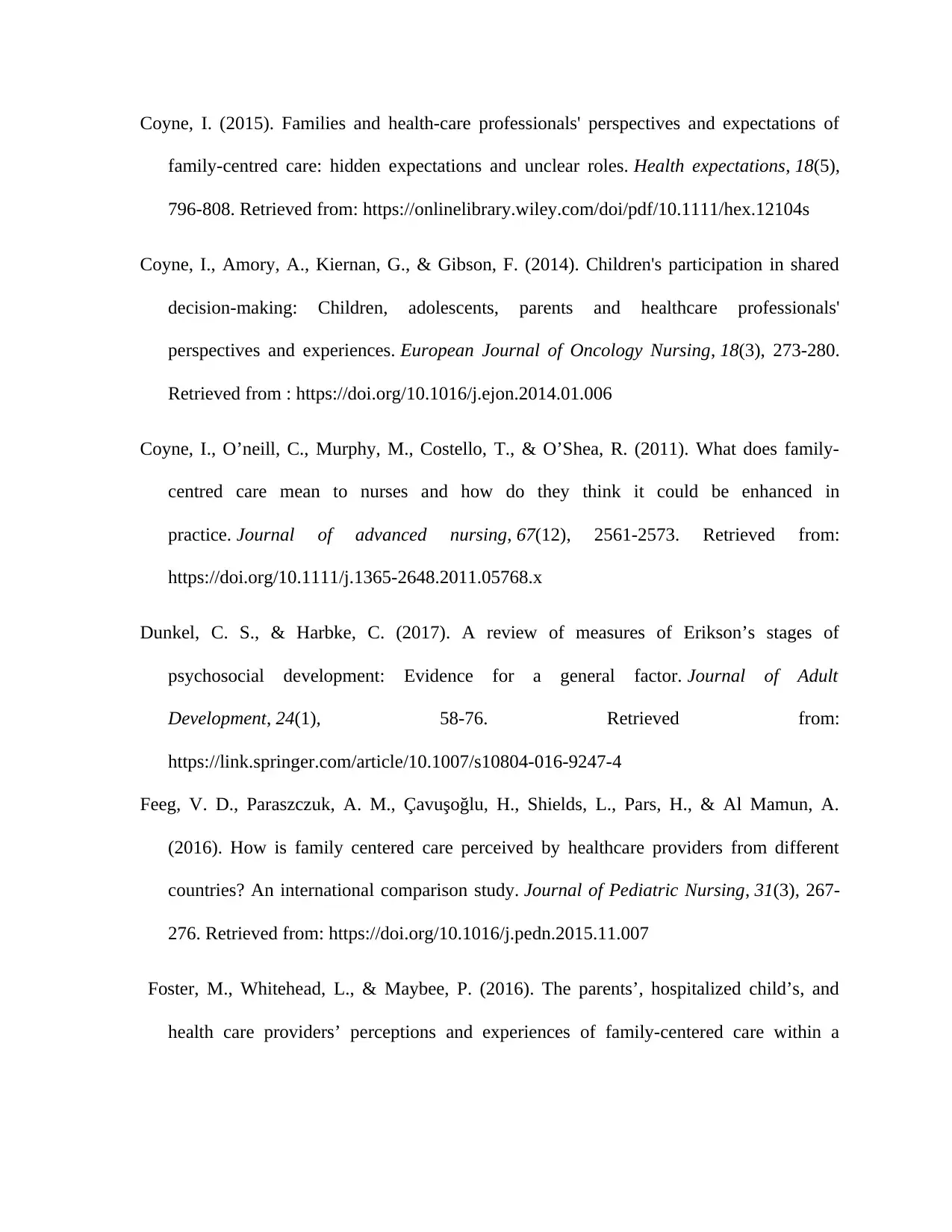
Coyne, I. (2015). Families and health‐care professionals' perspectives and expectations of
family‐centred care: hidden expectations and unclear roles. Health expectations, 18(5),
796-808. Retrieved from: https://onlinelibrary.wiley.com/doi/pdf/10.1111/hex.12104s
Coyne, I., Amory, A., Kiernan, G., & Gibson, F. (2014). Children's participation in shared
decision-making: Children, adolescents, parents and healthcare professionals'
perspectives and experiences. European Journal of Oncology Nursing, 18(3), 273-280.
Retrieved from : https://doi.org/10.1016/j.ejon.2014.01.006
Coyne, I., O’neill, C., Murphy, M., Costello, T., & O’Shea, R. (2011). What does family‐
centred care mean to nurses and how do they think it could be enhanced in
practice. Journal of advanced nursing, 67(12), 2561-2573. Retrieved from:
https://doi.org/10.1111/j.1365-2648.2011.05768.x
Dunkel, C. S., & Harbke, C. (2017). A review of measures of Erikson’s stages of
psychosocial development: Evidence for a general factor. Journal of Adult
Development, 24(1), 58-76. Retrieved from:
https://link.springer.com/article/10.1007/s10804-016-9247-4
Feeg, V. D., Paraszczuk, A. M., Çavuşoğlu, H., Shields, L., Pars, H., & Al Mamun, A.
(2016). How is family centered care perceived by healthcare providers from different
countries? An international comparison study. Journal of Pediatric Nursing, 31(3), 267-
276. Retrieved from: https://doi.org/10.1016/j.pedn.2015.11.007
Foster, M., Whitehead, L., & Maybee, P. (2016). The parents’, hospitalized child’s, and
health care providers’ perceptions and experiences of family-centered care within a
family‐centred care: hidden expectations and unclear roles. Health expectations, 18(5),
796-808. Retrieved from: https://onlinelibrary.wiley.com/doi/pdf/10.1111/hex.12104s
Coyne, I., Amory, A., Kiernan, G., & Gibson, F. (2014). Children's participation in shared
decision-making: Children, adolescents, parents and healthcare professionals'
perspectives and experiences. European Journal of Oncology Nursing, 18(3), 273-280.
Retrieved from : https://doi.org/10.1016/j.ejon.2014.01.006
Coyne, I., O’neill, C., Murphy, M., Costello, T., & O’Shea, R. (2011). What does family‐
centred care mean to nurses and how do they think it could be enhanced in
practice. Journal of advanced nursing, 67(12), 2561-2573. Retrieved from:
https://doi.org/10.1111/j.1365-2648.2011.05768.x
Dunkel, C. S., & Harbke, C. (2017). A review of measures of Erikson’s stages of
psychosocial development: Evidence for a general factor. Journal of Adult
Development, 24(1), 58-76. Retrieved from:
https://link.springer.com/article/10.1007/s10804-016-9247-4
Feeg, V. D., Paraszczuk, A. M., Çavuşoğlu, H., Shields, L., Pars, H., & Al Mamun, A.
(2016). How is family centered care perceived by healthcare providers from different
countries? An international comparison study. Journal of Pediatric Nursing, 31(3), 267-
276. Retrieved from: https://doi.org/10.1016/j.pedn.2015.11.007
Foster, M., Whitehead, L., & Maybee, P. (2016). The parents’, hospitalized child’s, and
health care providers’ perceptions and experiences of family-centered care within a
Paraphrase This Document
Need a fresh take? Get an instant paraphrase of this document with our AI Paraphraser
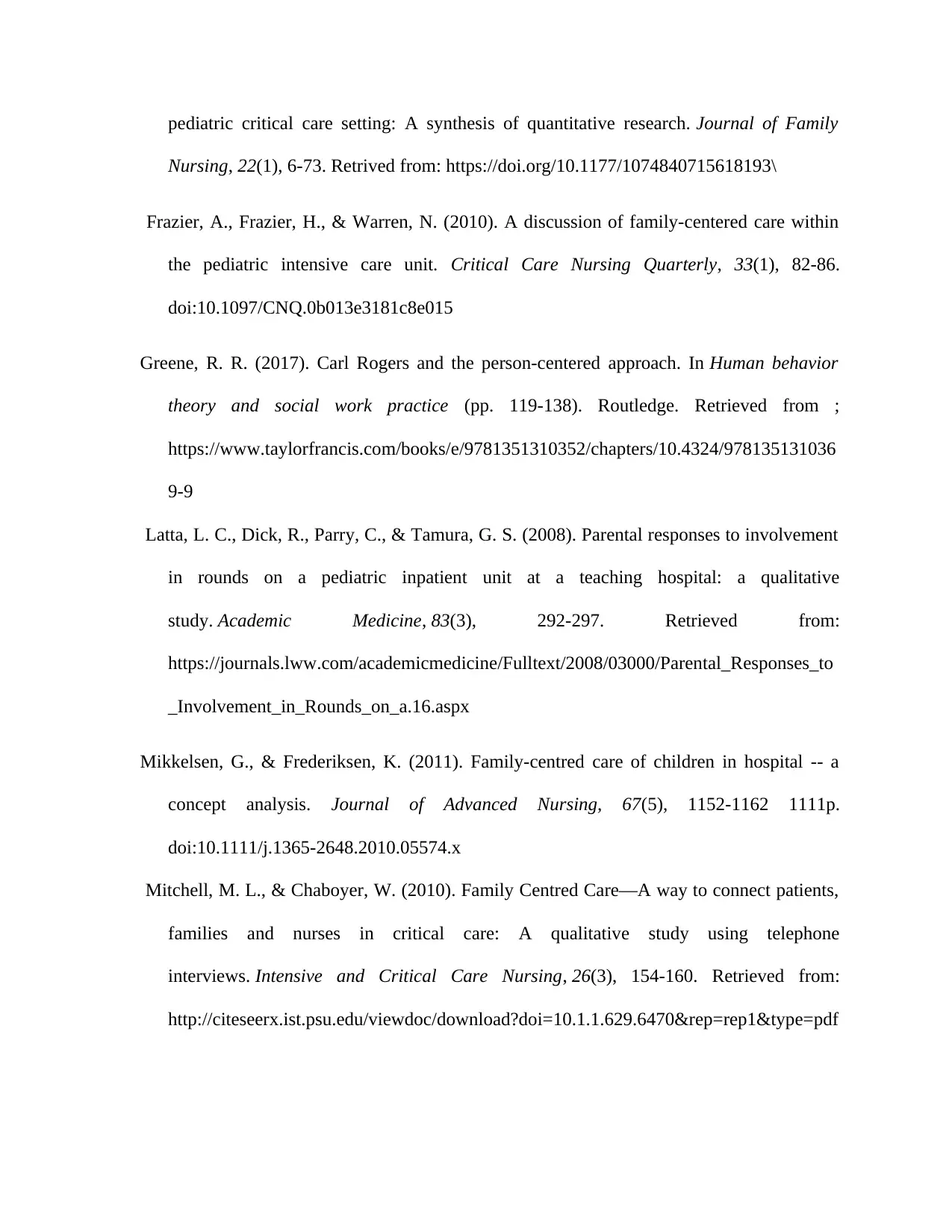
pediatric critical care setting: A synthesis of quantitative research. Journal of Family
Nursing, 22(1), 6-73. Retrived from: https://doi.org/10.1177/1074840715618193\
Frazier, A., Frazier, H., & Warren, N. (2010). A discussion of family-centered care within
the pediatric intensive care unit. Critical Care Nursing Quarterly, 33(1), 82-86.
doi:10.1097/CNQ.0b013e3181c8e015
Greene, R. R. (2017). Carl Rogers and the person-centered approach. In Human behavior
theory and social work practice (pp. 119-138). Routledge. Retrieved from ;
https://www.taylorfrancis.com/books/e/9781351310352/chapters/10.4324/978135131036
9-9
Latta, L. C., Dick, R., Parry, C., & Tamura, G. S. (2008). Parental responses to involvement
in rounds on a pediatric inpatient unit at a teaching hospital: a qualitative
study. Academic Medicine, 83(3), 292-297. Retrieved from:
https://journals.lww.com/academicmedicine/Fulltext/2008/03000/Parental_Responses_to
_Involvement_in_Rounds_on_a.16.aspx
Mikkelsen, G., & Frederiksen, K. (2011). Family-centred care of children in hospital -- a
concept analysis. Journal of Advanced Nursing, 67(5), 1152-1162 1111p.
doi:10.1111/j.1365-2648.2010.05574.x
Mitchell, M. L., & Chaboyer, W. (2010). Family Centred Care—A way to connect patients,
families and nurses in critical care: A qualitative study using telephone
interviews. Intensive and Critical Care Nursing, 26(3), 154-160. Retrieved from:
http://citeseerx.ist.psu.edu/viewdoc/download?doi=10.1.1.629.6470&rep=rep1&type=pdf
Nursing, 22(1), 6-73. Retrived from: https://doi.org/10.1177/1074840715618193\
Frazier, A., Frazier, H., & Warren, N. (2010). A discussion of family-centered care within
the pediatric intensive care unit. Critical Care Nursing Quarterly, 33(1), 82-86.
doi:10.1097/CNQ.0b013e3181c8e015
Greene, R. R. (2017). Carl Rogers and the person-centered approach. In Human behavior
theory and social work practice (pp. 119-138). Routledge. Retrieved from ;
https://www.taylorfrancis.com/books/e/9781351310352/chapters/10.4324/978135131036
9-9
Latta, L. C., Dick, R., Parry, C., & Tamura, G. S. (2008). Parental responses to involvement
in rounds on a pediatric inpatient unit at a teaching hospital: a qualitative
study. Academic Medicine, 83(3), 292-297. Retrieved from:
https://journals.lww.com/academicmedicine/Fulltext/2008/03000/Parental_Responses_to
_Involvement_in_Rounds_on_a.16.aspx
Mikkelsen, G., & Frederiksen, K. (2011). Family-centred care of children in hospital -- a
concept analysis. Journal of Advanced Nursing, 67(5), 1152-1162 1111p.
doi:10.1111/j.1365-2648.2010.05574.x
Mitchell, M. L., & Chaboyer, W. (2010). Family Centred Care—A way to connect patients,
families and nurses in critical care: A qualitative study using telephone
interviews. Intensive and Critical Care Nursing, 26(3), 154-160. Retrieved from:
http://citeseerx.ist.psu.edu/viewdoc/download?doi=10.1.1.629.6470&rep=rep1&type=pdf
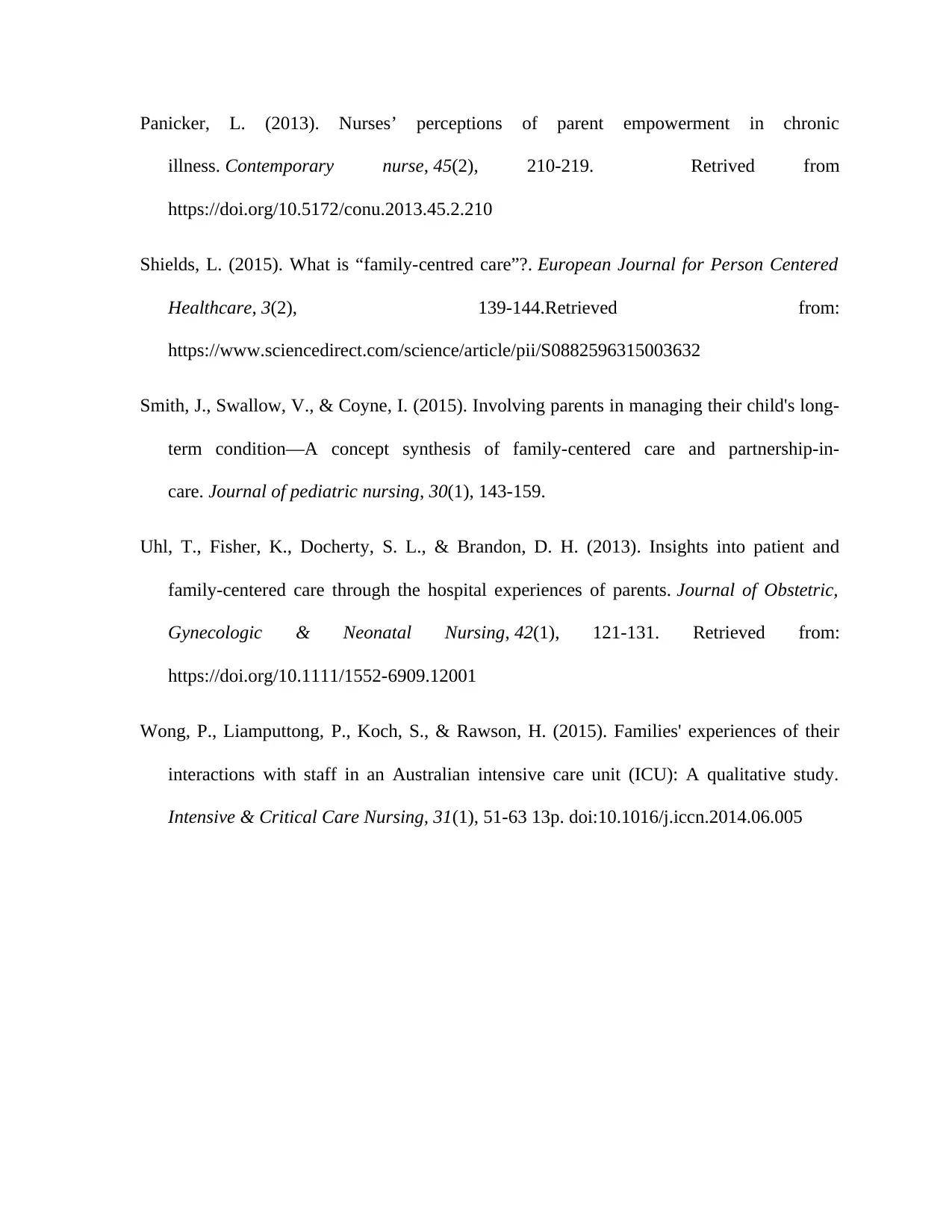
Panicker, L. (2013). Nurses’ perceptions of parent empowerment in chronic
illness. Contemporary nurse, 45(2), 210-219. Retrived from
https://doi.org/10.5172/conu.2013.45.2.210
Shields, L. (2015). What is “family-centred care”?. European Journal for Person Centered
Healthcare, 3(2), 139-144.Retrieved from:
https://www.sciencedirect.com/science/article/pii/S0882596315003632
Smith, J., Swallow, V., & Coyne, I. (2015). Involving parents in managing their child's long-
term condition—A concept synthesis of family-centered care and partnership-in-
care. Journal of pediatric nursing, 30(1), 143-159.
Uhl, T., Fisher, K., Docherty, S. L., & Brandon, D. H. (2013). Insights into patient and
family‐centered care through the hospital experiences of parents. Journal of Obstetric,
Gynecologic & Neonatal Nursing, 42(1), 121-131. Retrieved from:
https://doi.org/10.1111/1552-6909.12001
Wong, P., Liamputtong, P., Koch, S., & Rawson, H. (2015). Families' experiences of their
interactions with staff in an Australian intensive care unit (ICU): A qualitative study.
Intensive & Critical Care Nursing, 31(1), 51-63 13p. doi:10.1016/j.iccn.2014.06.005
illness. Contemporary nurse, 45(2), 210-219. Retrived from
https://doi.org/10.5172/conu.2013.45.2.210
Shields, L. (2015). What is “family-centred care”?. European Journal for Person Centered
Healthcare, 3(2), 139-144.Retrieved from:
https://www.sciencedirect.com/science/article/pii/S0882596315003632
Smith, J., Swallow, V., & Coyne, I. (2015). Involving parents in managing their child's long-
term condition—A concept synthesis of family-centered care and partnership-in-
care. Journal of pediatric nursing, 30(1), 143-159.
Uhl, T., Fisher, K., Docherty, S. L., & Brandon, D. H. (2013). Insights into patient and
family‐centered care through the hospital experiences of parents. Journal of Obstetric,
Gynecologic & Neonatal Nursing, 42(1), 121-131. Retrieved from:
https://doi.org/10.1111/1552-6909.12001
Wong, P., Liamputtong, P., Koch, S., & Rawson, H. (2015). Families' experiences of their
interactions with staff in an Australian intensive care unit (ICU): A qualitative study.
Intensive & Critical Care Nursing, 31(1), 51-63 13p. doi:10.1016/j.iccn.2014.06.005
⊘ This is a preview!⊘
Do you want full access?
Subscribe today to unlock all pages.

Trusted by 1+ million students worldwide
1 out of 12
Related Documents
Your All-in-One AI-Powered Toolkit for Academic Success.
+13062052269
info@desklib.com
Available 24*7 on WhatsApp / Email
![[object Object]](/_next/static/media/star-bottom.7253800d.svg)
Unlock your academic potential
Copyright © 2020–2025 A2Z Services. All Rights Reserved. Developed and managed by ZUCOL.





